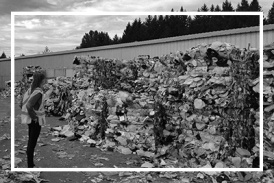The Union Bank Company backs local nonprofits
Bank donations aid Ohio organizations addressing key social needs
The Union Bank Co. continues to prioritize giving back to organizations that work directly with families and individuals facing hardship. Donation recipients include a diverse group of nonprofits making meaningful changes across Ohio and beyond:
• Family Promise of Lima and Allen County
• Black Heritage Council of Marion County
• Habitat for Humanity of Paulding County
• Habitat for Humanity of Wood County
• BAPs Charities
• Caring and Sharing Food Pantry
• Sandusky County Habitat for Humanity
This latest round of giving reflects The Union Bank Co.’s ongoing commitment to corporate responsibility and community connection. The bank looks forward to continuing its partnerships and deepening its impact in the months ahead.
“The organizations we choose to support often reflect the passions of our dedicated team members who are deeply engaged in their local communities,” said Dian Franks, marketing director at The Union Bank Co. “They champion a wide range of impactful causes close to their hearts, and we are committed to giving back to each and every one of them.”
Through its charitable giving, The Union Bank Company reinforces its long-standing commitment to building stronger, more resilient, and connected communities across Ohio.
***
ABOUT THE UNION BANK COMPANY:
Since 1904, The Union Bank Company has been here to provide full-service banking to the people and businesses throughout the communities we serve. Today, the bank has 14 full-service branch locations across Northwest and Central Ohio, including Bowling Green, Columbus Grove, Delphos, Findlay, Gibsonburg, Kalida, Leipsic, Lewis Center, Lima, Marion, Ottawa, Paulding, and Pemberville. We have Interactive Teller Machines (ITMs) located at all of our branch locations with additional ITM-only locations in Lima, Marion, Paulding, and Westerville. The Union Bank Company is headquartered in Columbus Grove, Ohio, and remains committed to providing the best banking services and products to all the communities we serve. Learn more at www.theubank.com.
Alexa Hess
BPR International
+1 740-624-2983
alexa|bpr.international| |alexa|bpr.international
Visit us on social media:
LinkedIn
Instagram
Facebook
YouTube
X
Legal Disclaimer:
EIN Presswire provides this news content "as is" without warranty of any kind. We do not accept any responsibility or liability for the accuracy, content, images, videos, licenses, completeness, legality, or reliability of the information contained in this article. If you have any complaints or copyright issues related to this article, kindly contact the author above.
Trusted Legal Guidance for Families in Times of Transition
Critter Stop Offers Permanent Solutions to Homes and Businesses with Launch of Pest Control in Richardson, Texas
Protection Tax Helps Clients Resolve Unfiled Returns Before IRS Action Escalates
Kalendarium
Więcej ważnych informacji
 Jedynka Newserii
Jedynka Newserii

 Jedynka Newserii
Jedynka Newserii

Handel

Ze względu na różnice w cenach surowce wtórne przegrywają z pierwotnymi. To powoduje problemy branży recyklingowej
Rozporządzenie PPWR stawia ambitne cele w zakresie wykorzystania recyklatów w poszczególnych rodzajach opakowań. To będzie oznaczało wzrost popytu na materiały wtórne pochodzące z recyklingu. Obecnie problemy branży recyklingu mogą spowodować, że popyt będzie zaspokajany głównie przez import. Dziś do dobrowolnego wykorzystania recyklatów nie zachęcają przede wszystkim ceny – surowiec pierwotny można kupić taniej niż ten z recyklingu.
Przemysł spożywczy
Rośnie presja konkurencyjna na unijne rolnictwo. Bez rekompensat sytuacja rolników może się pogarszać

Rolnictwo i żywność, w tym rybołówstwo, są sektorami strategicznymi dla UE. System rolno-spożywczy, oparty na jednolitym rynku europejskim, wytwarza ponad 900 mld euro wartości dodanej. Jego konkurencyjność stoi jednak przed wieloma wyzwaniami – to przede wszystkim eksport z Ukrainy i niedługo także z krajów Mercosur, a także presja związana z oczekiwaniami konsumentów i Zielonym Ładem. Bez rekompensat rolnikom może być trudno tym wyzwaniom sprostać.
Transport
Infrastruktury ładowania elektryków przybywa w szybkim tempie. Inwestorzy jednak napotykają szereg barier

Liczba punktów ładowania samochodów elektrycznych wynosi dziś ok. 10 tys., a tempo wzrostu wynosi ok. 50 proc. r/r. Dynamika ta przez wiele miesięcy była wyższa niż wyniki samego rynku samochodów elektrycznych, na które w poprzednim roku wpływało zawieszenie rządowych dopłat do zakupu elektryka. Pierwszy kwartał br. zamknął się 22-proc. wzrostem liczby rejestracji w ujęciu rocznym, ale kwiecień przyniósł już wyraźne odbicie – o 100 proc.
Partner serwisu
Szkolenia

Akademia Newserii
Akademia Newserii to projekt, w ramach którego najlepsi polscy dziennikarze biznesowi, giełdowi oraz lifestylowi, a także szkoleniowcy z wieloletnim doświadczeniem dzielą się swoją wiedzą nt. pracy z mediami.









.gif)

 |
| |
| |
|